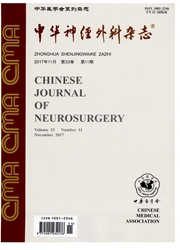

 中文摘要:
中文摘要:
目的建立人脊索瘤细胞系,为今后深入开展脊索瘤的研究奠定基础。方法手术获得新鲜人脊索瘤组织标本,经机械法和反复贴壁法进行原代培养和细胞纯化,接种到DMEM/F-12的培养基中进行传代培养,稳定传代15代。相差显微镜观察细胞的形态变化,透射电镜观察细胞器特点,免疫组化S100、Galectin-3、Fascin-1、Brachyury染色检测脊索瘤特异性标准蛋白的表达,流式细胞术检测细胞周期、吉姆萨染色体核型分析,裸鼠皮下注射验证细胞的成瘤性。结果相差显微镜下细胞内可见大量空泡状结构,电镜下胞质内为大量低电子密度的黏液空泡,免疫组化染色S100、Galectin-3、Fascin-1、Brachyury蛋白均呈阳性表达,流式细胞术检测细胞周期各时相的百分率分别为G1期51.3%、S期23.6%、G2-M期25.0%、G2/G1≈2,染色体核心分析细胞为异倍体核型,细胞注入裸鼠皮下有肿瘤形成。结论成功建立脊索瘤细胞系HBC2,长期传代后仍能保持脊索瘤细胞特性。
 英文摘要:
英文摘要:
Objective To establish human chordoma cell lines. Methods The tumor tissue samples were obtained from surgery. The tumor cells were mechanically dissociated and purified based on the different rates of attachment among various cell types. The cells were cultured in DMEM/F - 12 medium and passaged in vitro. The morphology and ultrastructure of tumor cells (passage 15 ) were observed by microscope and electron microscope. The proteins S100, Galectin- 3, Fascin- land Brachyury were measured by histochemical staining. Four phases of the cell cycle was analyzed by the flow cytometer. The karyotype analysis of tumor cells was performed. The tumor cells were subcutaneously injected into the nude mice. Results The HBC2 cell line was characterized by prominent vacuoles of mucus pushing the nuclei to the side. The proteins S100, Galectin - 3, Fascin - 1 and Brachyury were positively stained in the cell line. The flow cytometer showed 51.3% of the cells were at Gl phase, 23.6% at S, and 25.0% at G2 - M. The value of G2/G1 was almost 2. The heteroploid karyotype of the cells was indicated. The tumor formation in nude mice was found by HBC2 cells thansplantation. Conclusions Human chordoma cell line HBC2 was successfully established and cultured in vitro on the basis of maintaining its characteristics of chordoma in the process of passage.
 同期刊论文项目
同期刊论文项目
 同项目期刊论文
同项目期刊论文
 期刊信息
期刊信息
